International Financial Management
VerifiedAdded on 2022/11/13
|11
|1795
|116
AI Summary
This document covers various topics related to International Financial Management such as transaction, economic and translation exposure, hedging exchange exposures, credit shortage, SIV and CDO. It also provides solved assignments, essays, dissertation and more at Desklib.
Contribute Materials
Your contribution can guide someone’s learning journey. Share your
documents today.
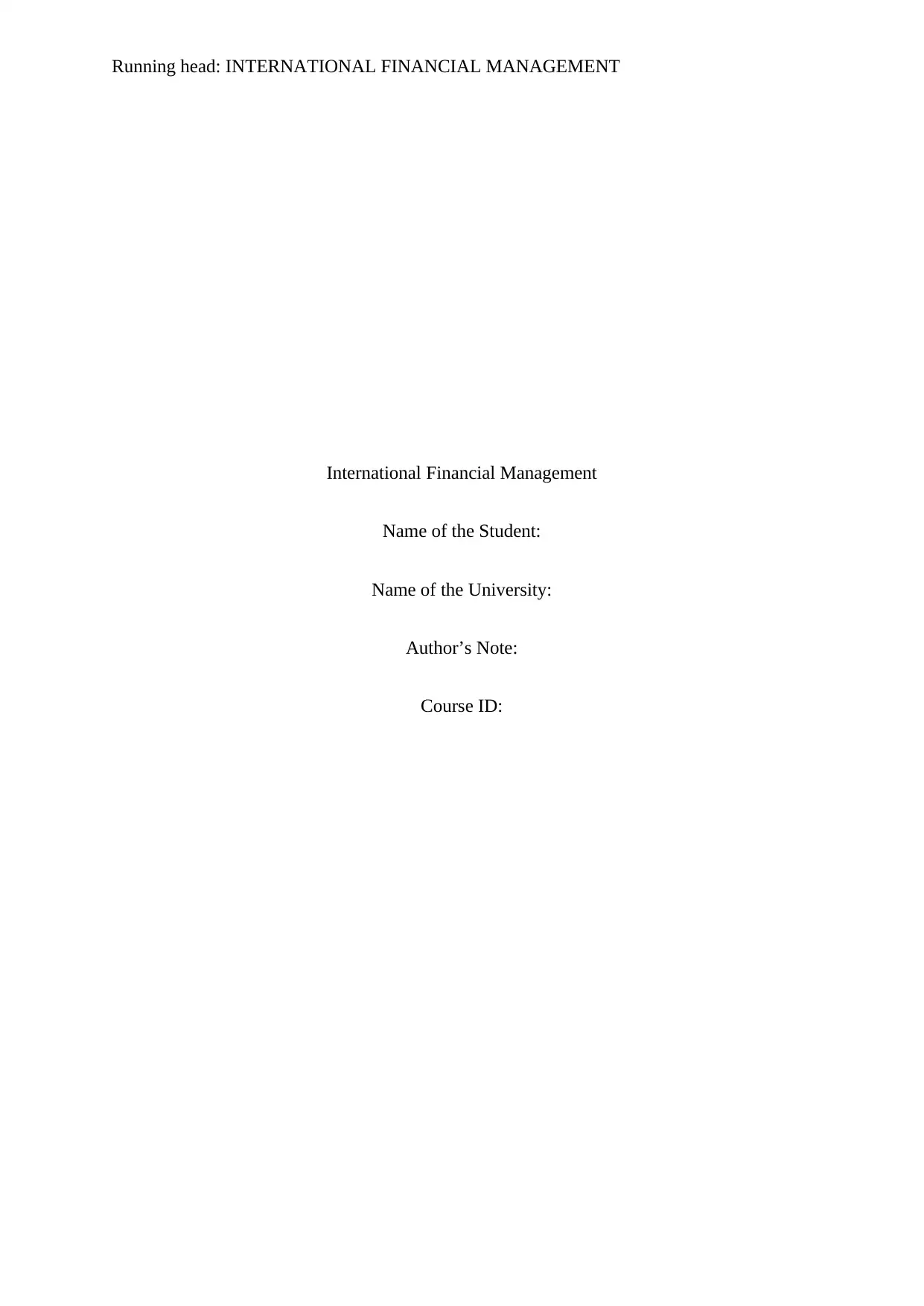
Running head: INTERNATIONAL FINANCIAL MANAGEMENT
International Financial Management
Name of the Student:
Name of the University:
Author’s Note:
Course ID:
International Financial Management
Name of the Student:
Name of the University:
Author’s Note:
Course ID:
Secure Best Marks with AI Grader
Need help grading? Try our AI Grader for instant feedback on your assignments.
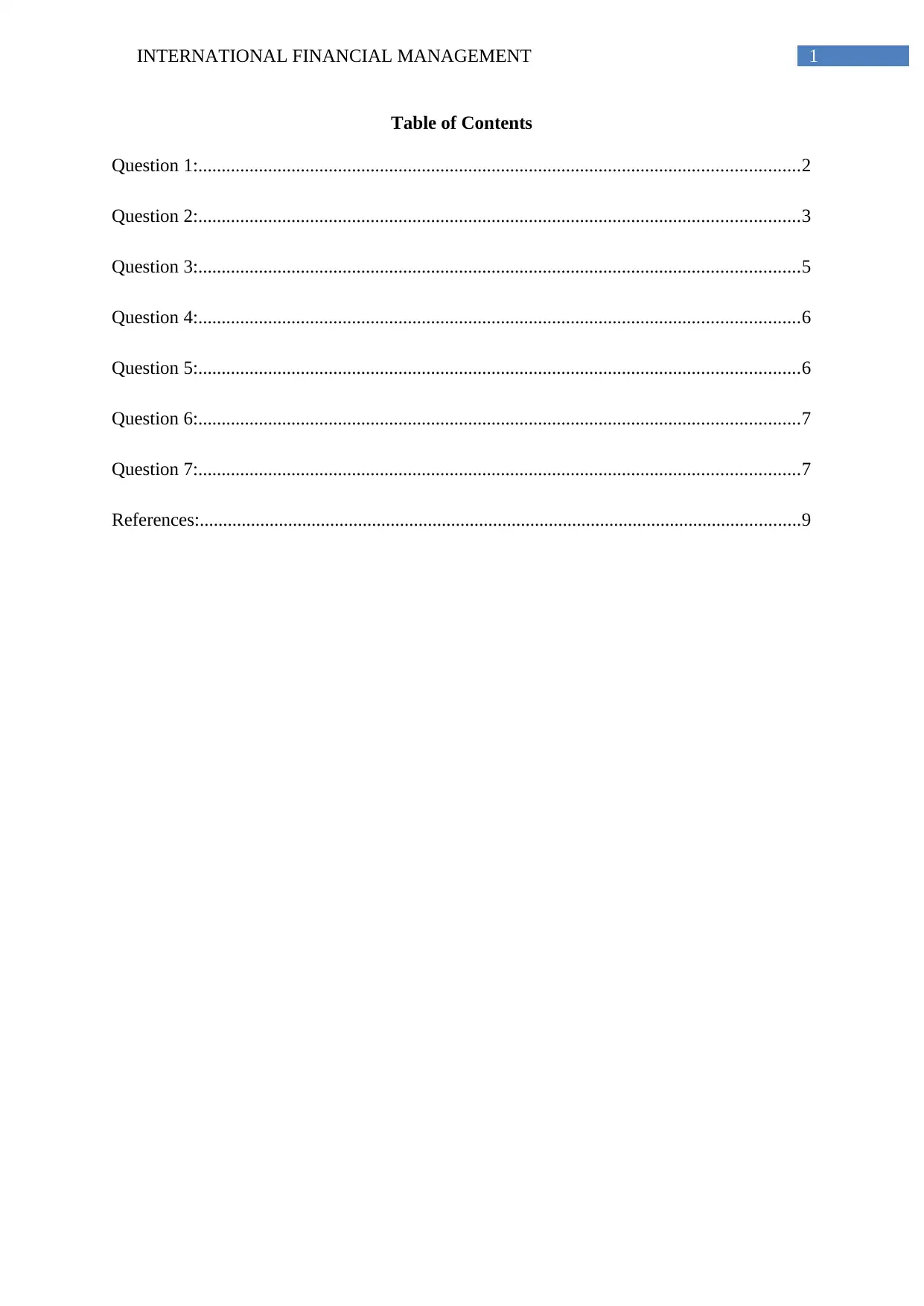
1INTERNATIONAL FINANCIAL MANAGEMENT
Table of Contents
Question 1:.................................................................................................................................2
Question 2:.................................................................................................................................3
Question 3:.................................................................................................................................5
Question 4:.................................................................................................................................6
Question 5:.................................................................................................................................6
Question 6:.................................................................................................................................7
Question 7:.................................................................................................................................7
References:.................................................................................................................................9
Table of Contents
Question 1:.................................................................................................................................2
Question 2:.................................................................................................................................3
Question 3:.................................................................................................................................5
Question 4:.................................................................................................................................6
Question 5:.................................................................................................................................6
Question 6:.................................................................................................................................7
Question 7:.................................................................................................................................7
References:.................................................................................................................................9
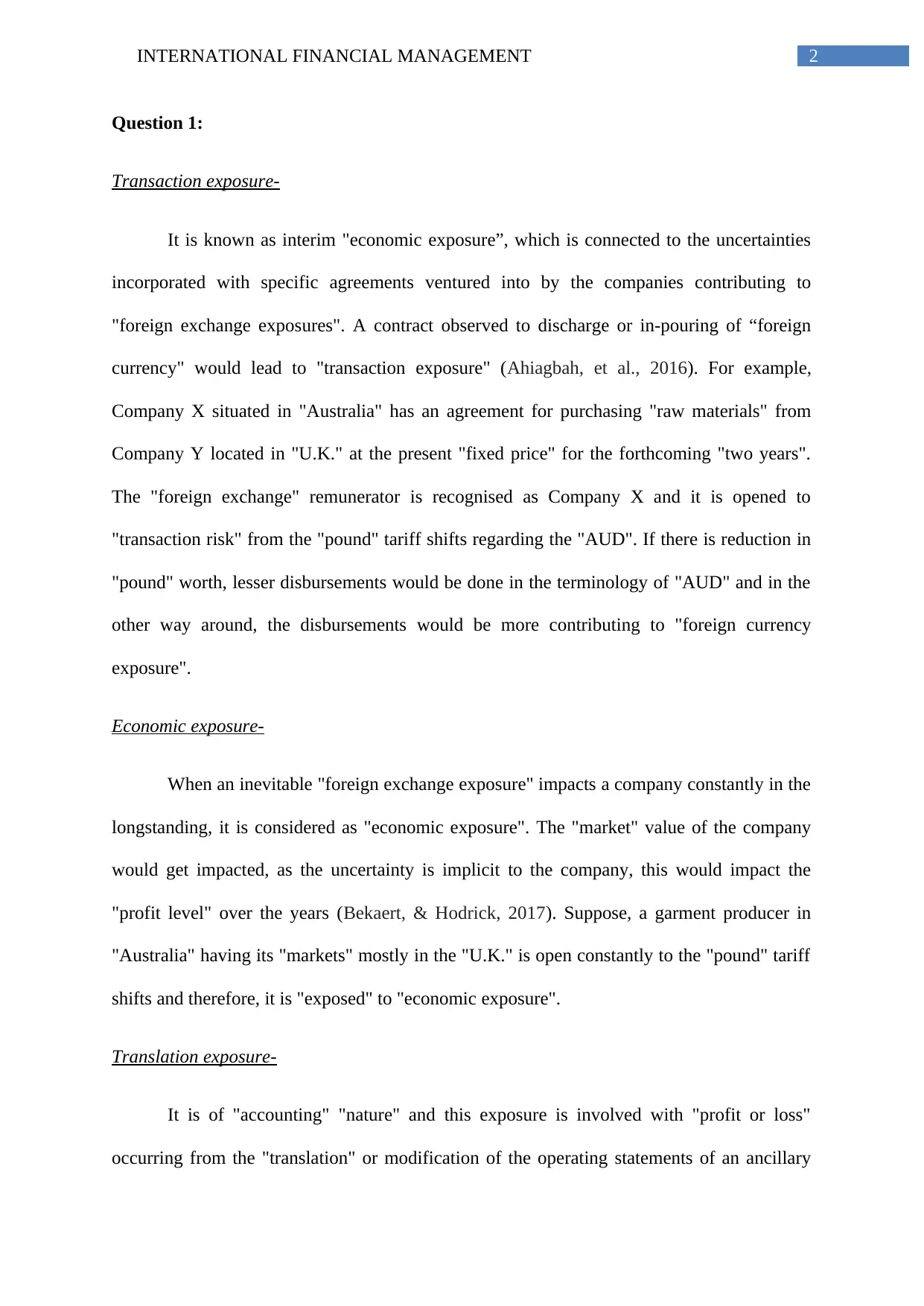
2INTERNATIONAL FINANCIAL MANAGEMENT
Question 1:
Transaction exposure-
It is known as interim "economic exposure”, which is connected to the uncertainties
incorporated with specific agreements ventured into by the companies contributing to
"foreign exchange exposures". A contract observed to discharge or in-pouring of “foreign
currency" would lead to "transaction exposure" (Ahiagbah, et al., 2016). For example,
Company X situated in "Australia" has an agreement for purchasing "raw materials" from
Company Y located in "U.K." at the present "fixed price" for the forthcoming "two years".
The "foreign exchange" remunerator is recognised as Company X and it is opened to
"transaction risk" from the "pound" tariff shifts regarding the "AUD". If there is reduction in
"pound" worth, lesser disbursements would be done in the terminology of "AUD" and in the
other way around, the disbursements would be more contributing to "foreign currency
exposure".
Economic exposure-
When an inevitable "foreign exchange exposure" impacts a company constantly in the
longstanding, it is considered as "economic exposure". The "market" value of the company
would get impacted, as the uncertainty is implicit to the company, this would impact the
"profit level" over the years (Bekaert, & Hodrick, 2017). Suppose, a garment producer in
"Australia" having its "markets" mostly in the "U.K." is open constantly to the "pound" tariff
shifts and therefore, it is "exposed" to "economic exposure".
Translation exposure-
It is of "accounting" "nature" and this exposure is involved with "profit or loss"
occurring from the "translation" or modification of the operating statements of an ancillary
Question 1:
Transaction exposure-
It is known as interim "economic exposure”, which is connected to the uncertainties
incorporated with specific agreements ventured into by the companies contributing to
"foreign exchange exposures". A contract observed to discharge or in-pouring of “foreign
currency" would lead to "transaction exposure" (Ahiagbah, et al., 2016). For example,
Company X situated in "Australia" has an agreement for purchasing "raw materials" from
Company Y located in "U.K." at the present "fixed price" for the forthcoming "two years".
The "foreign exchange" remunerator is recognised as Company X and it is opened to
"transaction risk" from the "pound" tariff shifts regarding the "AUD". If there is reduction in
"pound" worth, lesser disbursements would be done in the terminology of "AUD" and in the
other way around, the disbursements would be more contributing to "foreign currency
exposure".
Economic exposure-
When an inevitable "foreign exchange exposure" impacts a company constantly in the
longstanding, it is considered as "economic exposure". The "market" value of the company
would get impacted, as the uncertainty is implicit to the company, this would impact the
"profit level" over the years (Bekaert, & Hodrick, 2017). Suppose, a garment producer in
"Australia" having its "markets" mostly in the "U.K." is open constantly to the "pound" tariff
shifts and therefore, it is "exposed" to "economic exposure".
Translation exposure-
It is of "accounting" "nature" and this exposure is involved with "profit or loss"
occurring from the "translation" or modification of the operating statements of an ancillary
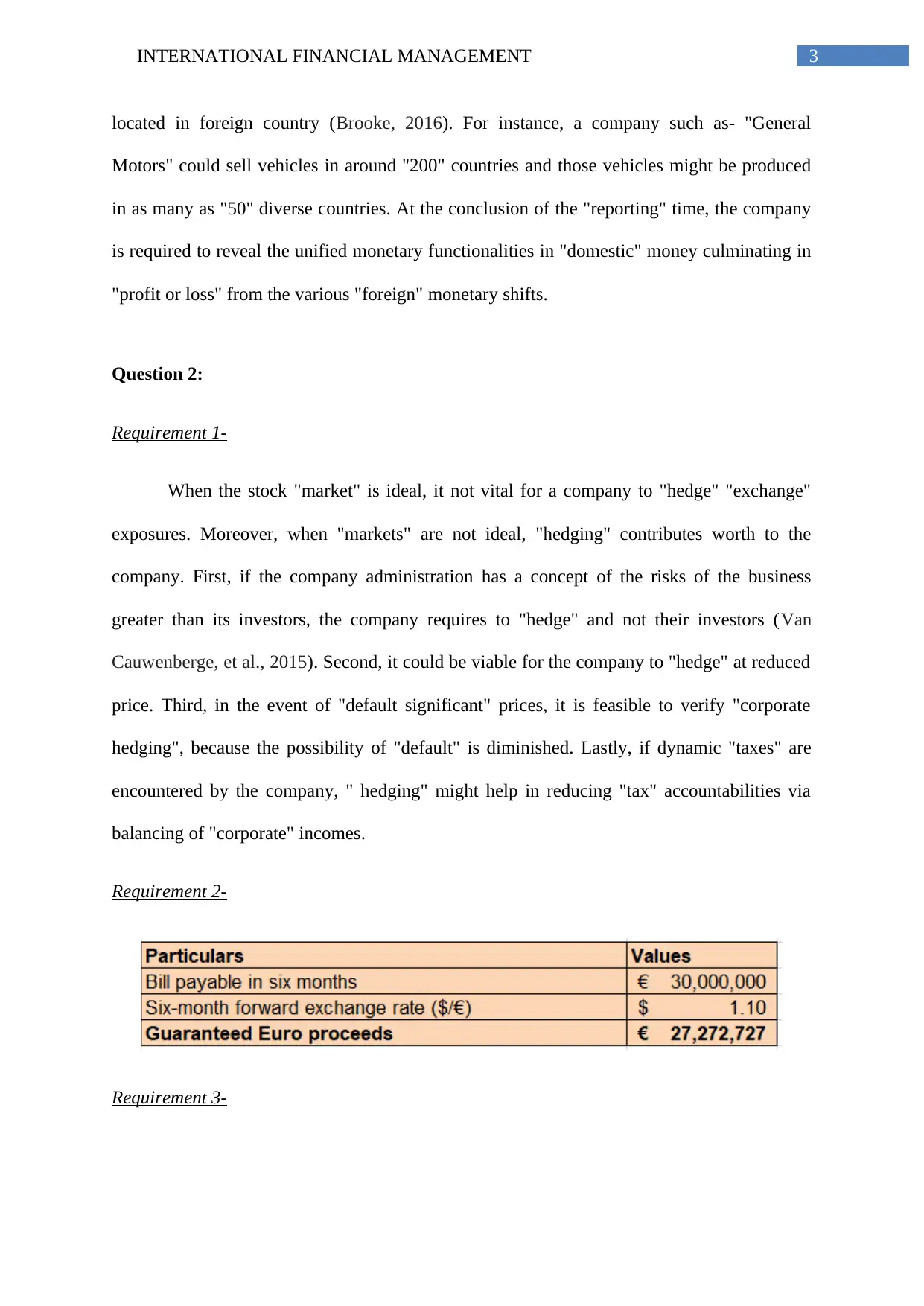
3INTERNATIONAL FINANCIAL MANAGEMENT
located in foreign country (Brooke, 2016). For instance, a company such as- "General
Motors" could sell vehicles in around "200" countries and those vehicles might be produced
in as many as "50" diverse countries. At the conclusion of the "reporting" time, the company
is required to reveal the unified monetary functionalities in "domestic" money culminating in
"profit or loss" from the various "foreign" monetary shifts.
Question 2:
Requirement 1-
When the stock "market" is ideal, it not vital for a company to "hedge" "exchange"
exposures. Moreover, when "markets" are not ideal, "hedging" contributes worth to the
company. First, if the company administration has a concept of the risks of the business
greater than its investors, the company requires to "hedge" and not their investors (Van
Cauwenberge, et al., 2015). Second, it could be viable for the company to "hedge" at reduced
price. Third, in the event of "default significant" prices, it is feasible to verify "corporate
hedging", because the possibility of "default" is diminished. Lastly, if dynamic "taxes" are
encountered by the company, " hedging" might help in reducing "tax" accountabilities via
balancing of "corporate" incomes.
Requirement 2-
Requirement 3-
located in foreign country (Brooke, 2016). For instance, a company such as- "General
Motors" could sell vehicles in around "200" countries and those vehicles might be produced
in as many as "50" diverse countries. At the conclusion of the "reporting" time, the company
is required to reveal the unified monetary functionalities in "domestic" money culminating in
"profit or loss" from the various "foreign" monetary shifts.
Question 2:
Requirement 1-
When the stock "market" is ideal, it not vital for a company to "hedge" "exchange"
exposures. Moreover, when "markets" are not ideal, "hedging" contributes worth to the
company. First, if the company administration has a concept of the risks of the business
greater than its investors, the company requires to "hedge" and not their investors (Van
Cauwenberge, et al., 2015). Second, it could be viable for the company to "hedge" at reduced
price. Third, in the event of "default significant" prices, it is feasible to verify "corporate
hedging", because the possibility of "default" is diminished. Lastly, if dynamic "taxes" are
encountered by the company, " hedging" might help in reducing "tax" accountabilities via
balancing of "corporate" incomes.
Requirement 2-
Requirement 3-
Secure Best Marks with AI Grader
Need help grading? Try our AI Grader for instant feedback on your assignments.
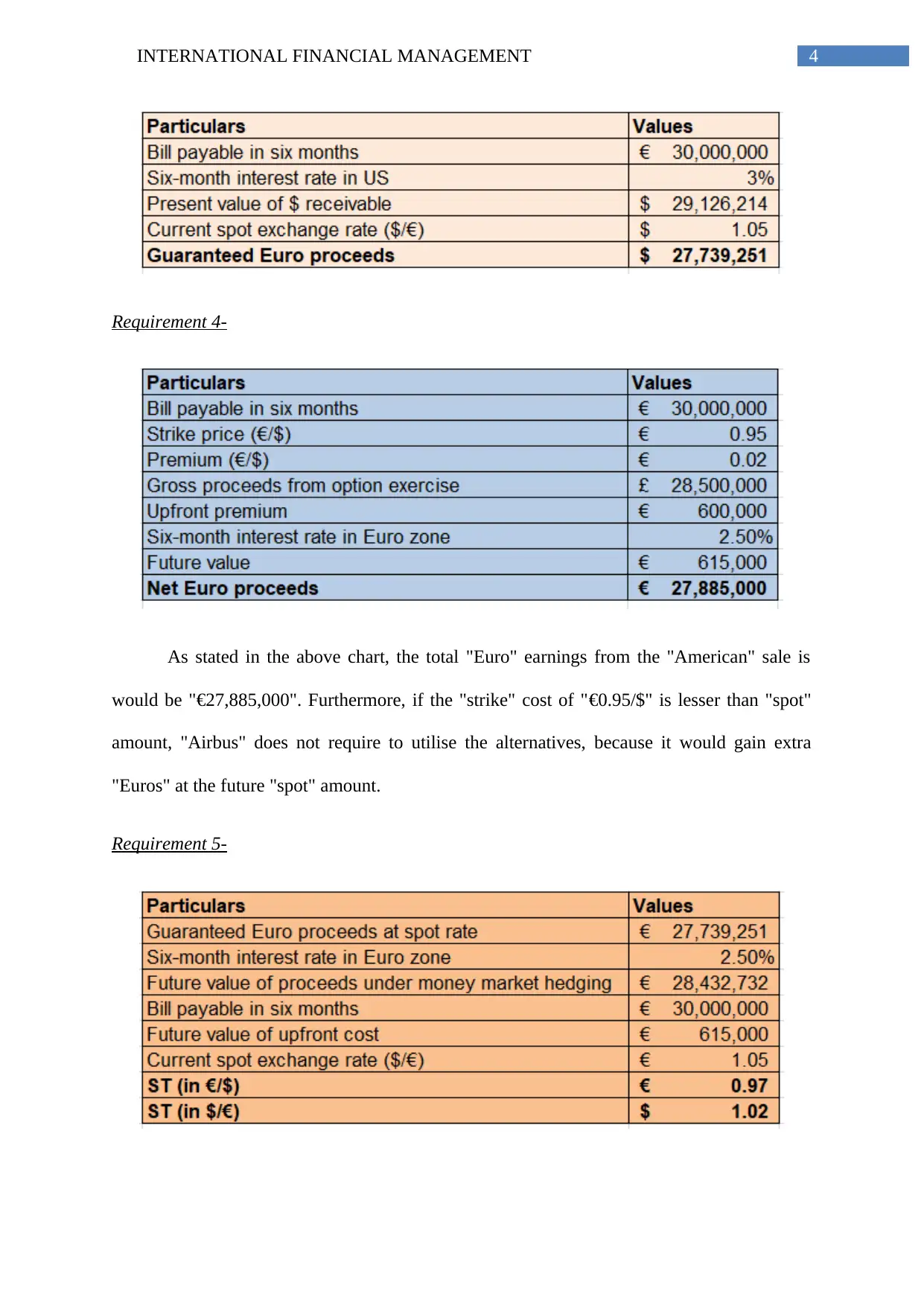
4INTERNATIONAL FINANCIAL MANAGEMENT
Requirement 4-
As stated in the above chart, the total "Euro" earnings from the "American" sale is
would be "€27,885,000". Furthermore, if the "strike" cost of "€0.95/$" is lesser than "spot"
amount, "Airbus" does not require to utilise the alternatives, because it would gain extra
"Euros" at the future "spot" amount.
Requirement 5-
Requirement 4-
As stated in the above chart, the total "Euro" earnings from the "American" sale is
would be "€27,885,000". Furthermore, if the "strike" cost of "€0.95/$" is lesser than "spot"
amount, "Airbus" does not require to utilise the alternatives, because it would gain extra
"Euros" at the future "spot" amount.
Requirement 5-
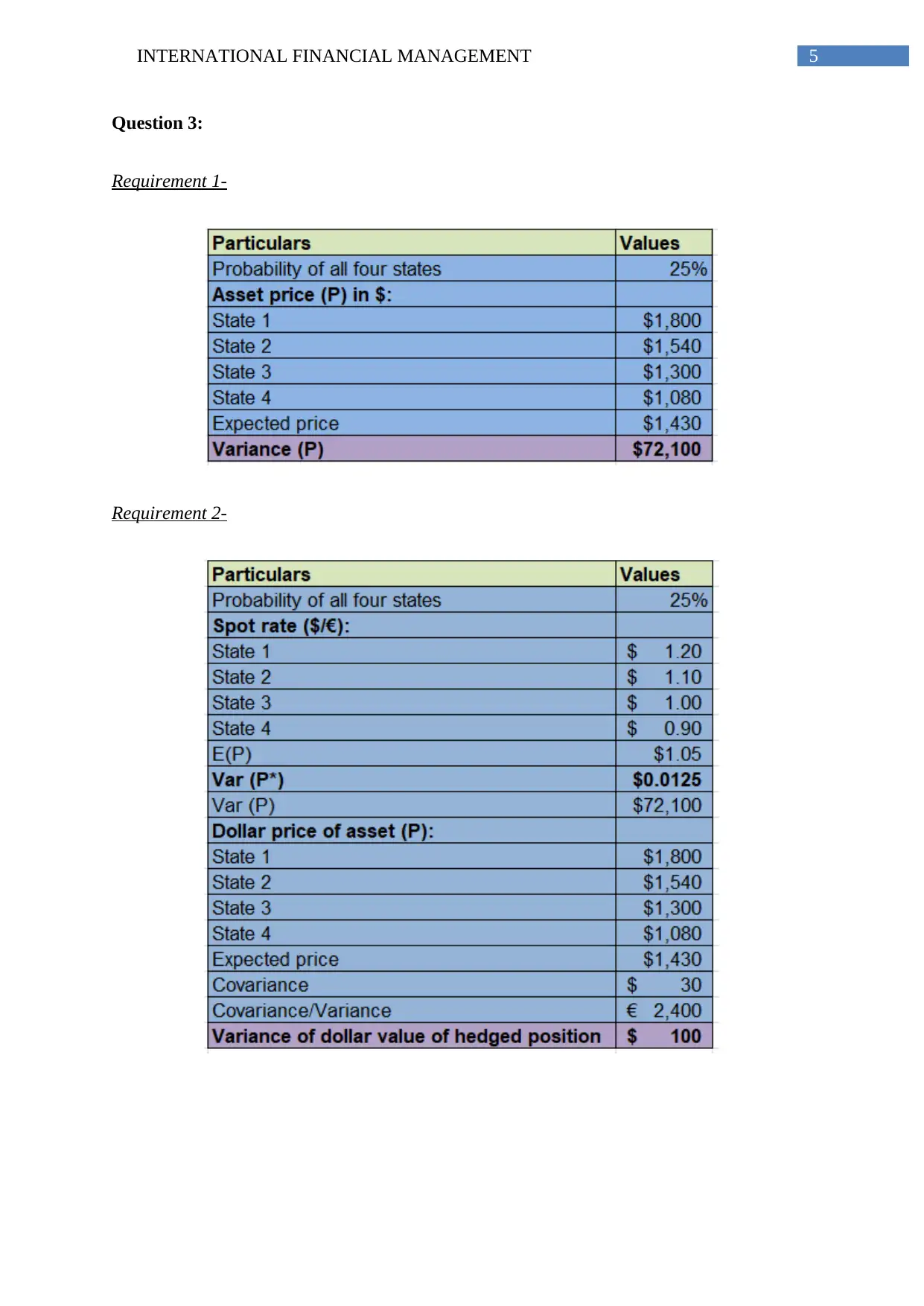
5INTERNATIONAL FINANCIAL MANAGEMENT
Question 3:
Requirement 1-
Requirement 2-
Question 3:
Requirement 1-
Requirement 2-
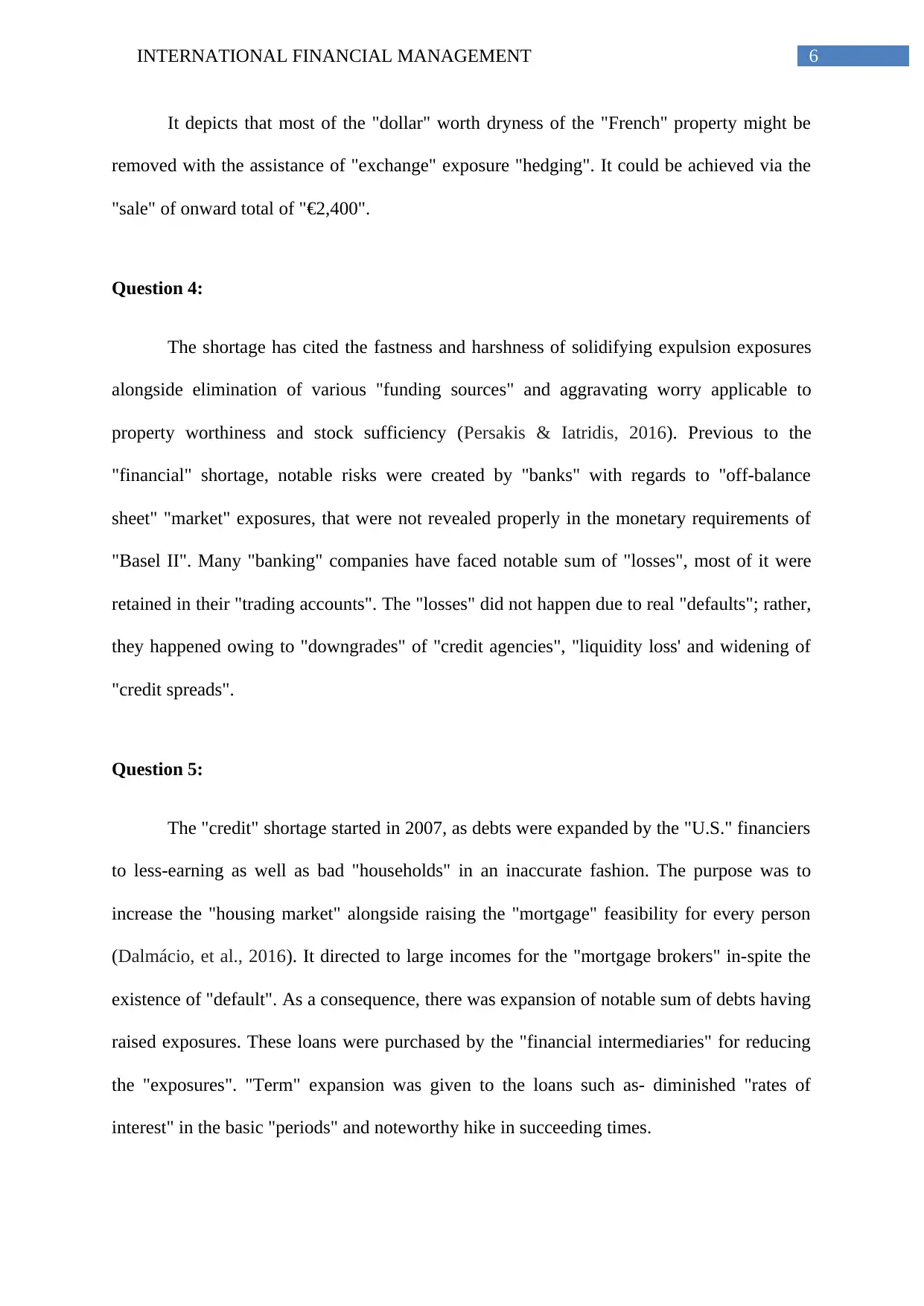
6INTERNATIONAL FINANCIAL MANAGEMENT
It depicts that most of the "dollar" worth dryness of the "French" property might be
removed with the assistance of "exchange" exposure "hedging". It could be achieved via the
"sale" of onward total of "€2,400".
Question 4:
The shortage has cited the fastness and harshness of solidifying expulsion exposures
alongside elimination of various "funding sources" and aggravating worry applicable to
property worthiness and stock sufficiency (Persakis & Iatridis, 2016). Previous to the
"financial" shortage, notable risks were created by "banks" with regards to "off-balance
sheet" "market" exposures, that were not revealed properly in the monetary requirements of
"Basel II". Many "banking" companies have faced notable sum of "losses", most of it were
retained in their "trading accounts". The "losses" did not happen due to real "defaults"; rather,
they happened owing to "downgrades" of "credit agencies", "liquidity loss' and widening of
"credit spreads".
Question 5:
The "credit" shortage started in 2007, as debts were expanded by the "U.S." financiers
to less-earning as well as bad "households" in an inaccurate fashion. The purpose was to
increase the "housing market" alongside raising the "mortgage" feasibility for every person
(Dalmácio, et al., 2016). It directed to large incomes for the "mortgage brokers" in-spite the
existence of "default". As a consequence, there was expansion of notable sum of debts having
raised exposures. These loans were purchased by the "financial intermediaries" for reducing
the "exposures". "Term" expansion was given to the loans such as- diminished "rates of
interest" in the basic "periods" and noteworthy hike in succeeding times.
It depicts that most of the "dollar" worth dryness of the "French" property might be
removed with the assistance of "exchange" exposure "hedging". It could be achieved via the
"sale" of onward total of "€2,400".
Question 4:
The shortage has cited the fastness and harshness of solidifying expulsion exposures
alongside elimination of various "funding sources" and aggravating worry applicable to
property worthiness and stock sufficiency (Persakis & Iatridis, 2016). Previous to the
"financial" shortage, notable risks were created by "banks" with regards to "off-balance
sheet" "market" exposures, that were not revealed properly in the monetary requirements of
"Basel II". Many "banking" companies have faced notable sum of "losses", most of it were
retained in their "trading accounts". The "losses" did not happen due to real "defaults"; rather,
they happened owing to "downgrades" of "credit agencies", "liquidity loss' and widening of
"credit spreads".
Question 5:
The "credit" shortage started in 2007, as debts were expanded by the "U.S." financiers
to less-earning as well as bad "households" in an inaccurate fashion. The purpose was to
increase the "housing market" alongside raising the "mortgage" feasibility for every person
(Dalmácio, et al., 2016). It directed to large incomes for the "mortgage brokers" in-spite the
existence of "default". As a consequence, there was expansion of notable sum of debts having
raised exposures. These loans were purchased by the "financial intermediaries" for reducing
the "exposures". "Term" expansion was given to the loans such as- diminished "rates of
interest" in the basic "periods" and noteworthy hike in succeeding times.
Paraphrase This Document
Need a fresh take? Get an instant paraphrase of this document with our AI Paraphraser
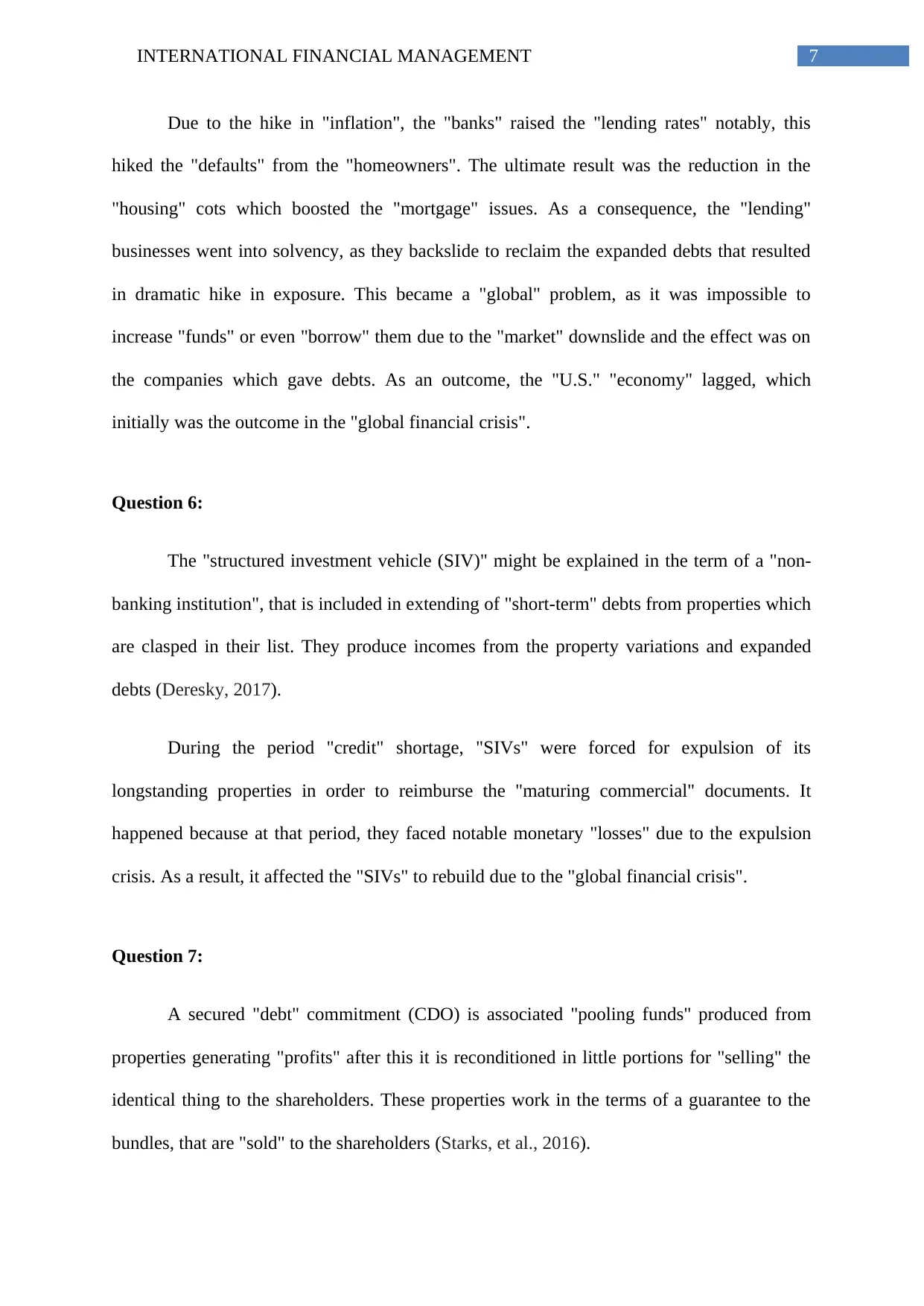
7INTERNATIONAL FINANCIAL MANAGEMENT
Due to the hike in "inflation", the "banks" raised the "lending rates" notably, this
hiked the "defaults" from the "homeowners". The ultimate result was the reduction in the
"housing" cots which boosted the "mortgage" issues. As a consequence, the "lending"
businesses went into solvency, as they backslide to reclaim the expanded debts that resulted
in dramatic hike in exposure. This became a "global" problem, as it was impossible to
increase "funds" or even "borrow" them due to the "market" downslide and the effect was on
the companies which gave debts. As an outcome, the "U.S." "economy" lagged, which
initially was the outcome in the "global financial crisis".
Question 6:
The "structured investment vehicle (SIV)" might be explained in the term of a "non-
banking institution", that is included in extending of "short-term" debts from properties which
are clasped in their list. They produce incomes from the property variations and expanded
debts (Deresky, 2017).
During the period "credit" shortage, "SIVs" were forced for expulsion of its
longstanding properties in order to reimburse the "maturing commercial" documents. It
happened because at that period, they faced notable monetary "losses" due to the expulsion
crisis. As a result, it affected the "SIVs" to rebuild due to the "global financial crisis".
Question 7:
A secured "debt" commitment (CDO) is associated "pooling funds" produced from
properties generating "profits" after this it is reconditioned in little portions for "selling" the
identical thing to the shareholders. These properties work in the terms of a guarantee to the
bundles, that are "sold" to the shareholders (Starks, et al., 2016).
Due to the hike in "inflation", the "banks" raised the "lending rates" notably, this
hiked the "defaults" from the "homeowners". The ultimate result was the reduction in the
"housing" cots which boosted the "mortgage" issues. As a consequence, the "lending"
businesses went into solvency, as they backslide to reclaim the expanded debts that resulted
in dramatic hike in exposure. This became a "global" problem, as it was impossible to
increase "funds" or even "borrow" them due to the "market" downslide and the effect was on
the companies which gave debts. As an outcome, the "U.S." "economy" lagged, which
initially was the outcome in the "global financial crisis".
Question 6:
The "structured investment vehicle (SIV)" might be explained in the term of a "non-
banking institution", that is included in extending of "short-term" debts from properties which
are clasped in their list. They produce incomes from the property variations and expanded
debts (Deresky, 2017).
During the period "credit" shortage, "SIVs" were forced for expulsion of its
longstanding properties in order to reimburse the "maturing commercial" documents. It
happened because at that period, they faced notable monetary "losses" due to the expulsion
crisis. As a result, it affected the "SIVs" to rebuild due to the "global financial crisis".
Question 7:
A secured "debt" commitment (CDO) is associated "pooling funds" produced from
properties generating "profits" after this it is reconditioned in little portions for "selling" the
identical thing to the shareholders. These properties work in the terms of a guarantee to the
bundles, that are "sold" to the shareholders (Starks, et al., 2016).
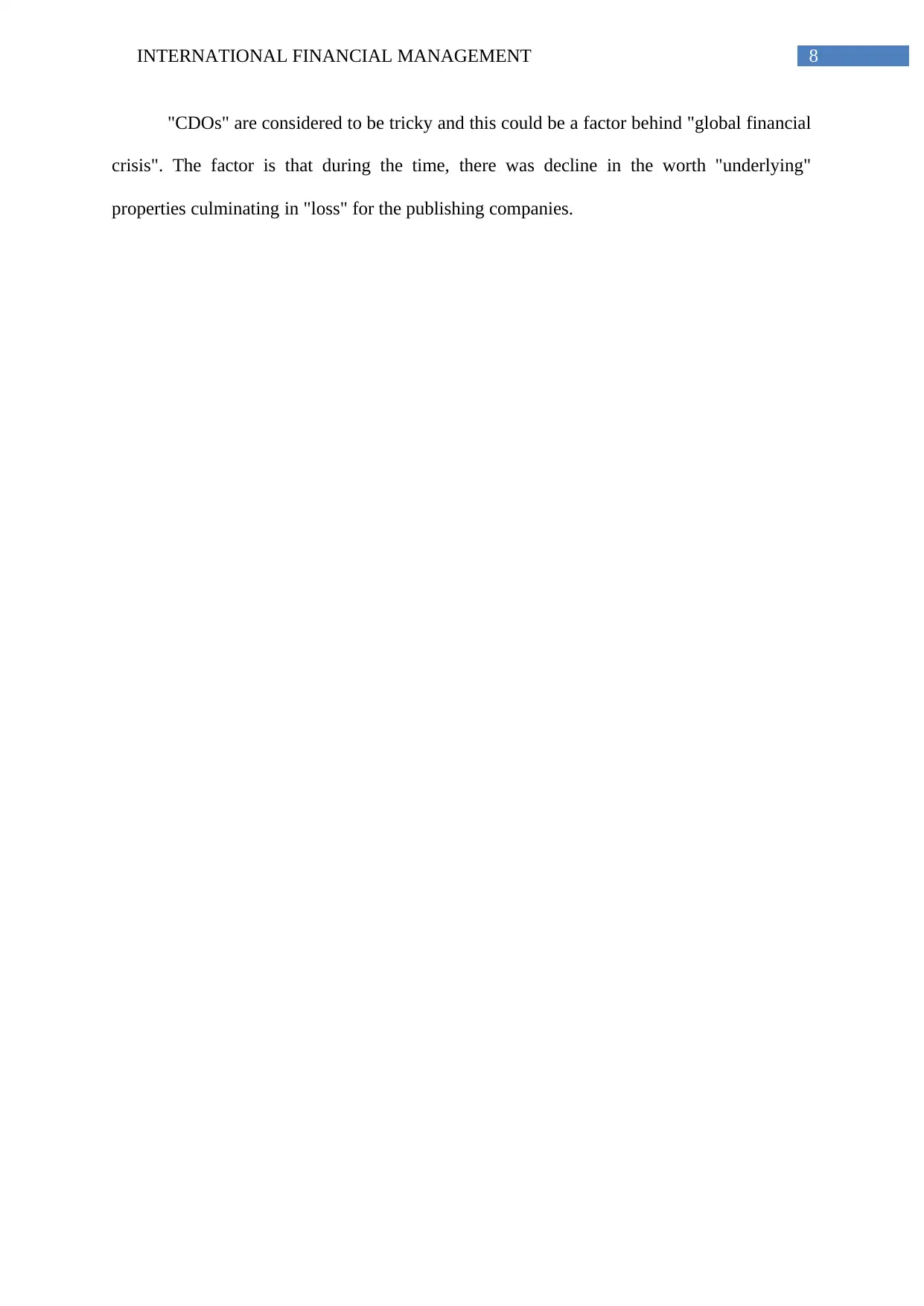
8INTERNATIONAL FINANCIAL MANAGEMENT
"CDOs" are considered to be tricky and this could be a factor behind "global financial
crisis". The factor is that during the time, there was decline in the worth "underlying"
properties culminating in "loss" for the publishing companies.
"CDOs" are considered to be tricky and this could be a factor behind "global financial
crisis". The factor is that during the time, there was decline in the worth "underlying"
properties culminating in "loss" for the publishing companies.
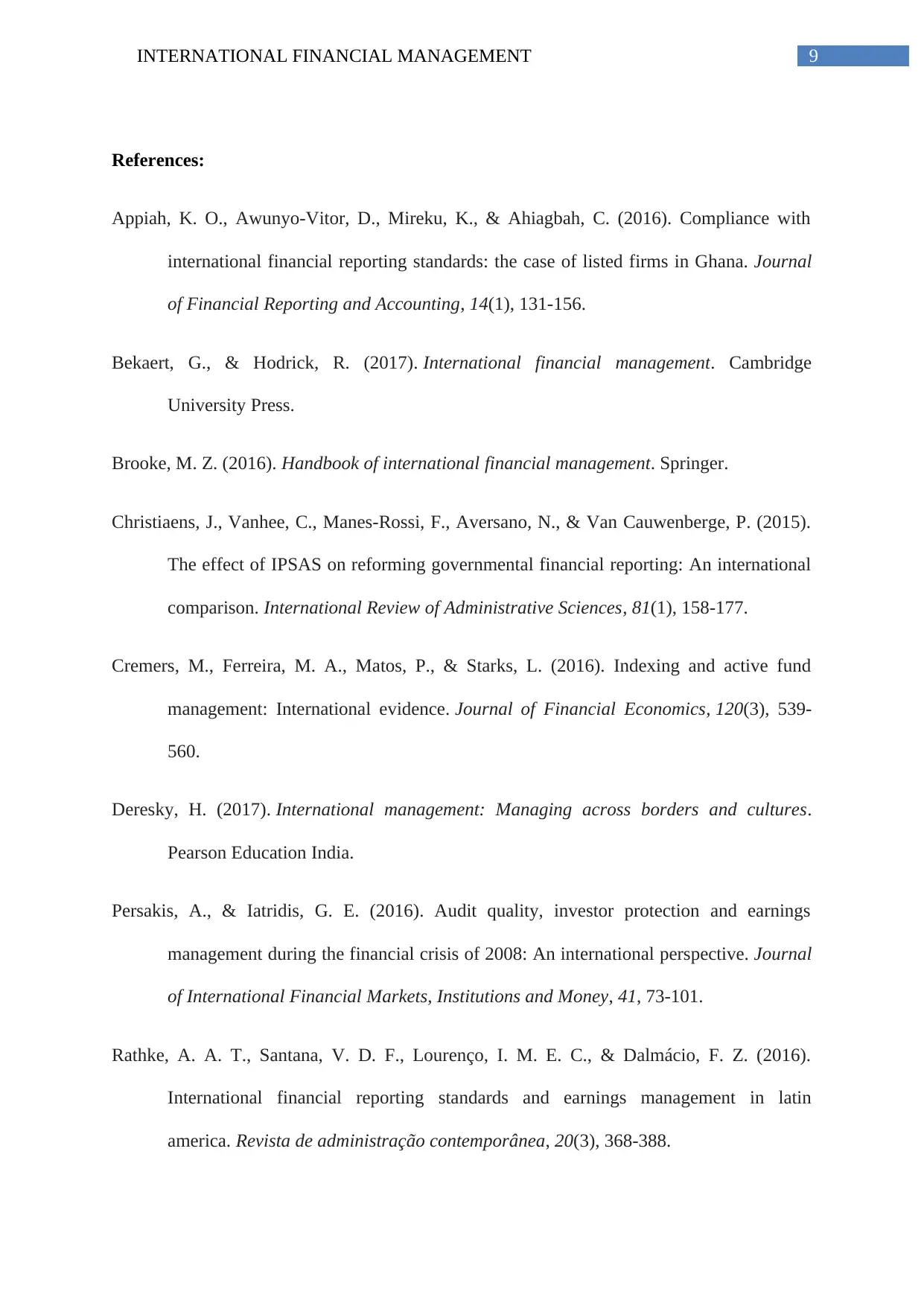
9INTERNATIONAL FINANCIAL MANAGEMENT
References:
Appiah, K. O., Awunyo-Vitor, D., Mireku, K., & Ahiagbah, C. (2016). Compliance with
international financial reporting standards: the case of listed firms in Ghana. Journal
of Financial Reporting and Accounting, 14(1), 131-156.
Bekaert, G., & Hodrick, R. (2017). International financial management. Cambridge
University Press.
Brooke, M. Z. (2016). Handbook of international financial management. Springer.
Christiaens, J., Vanhee, C., Manes-Rossi, F., Aversano, N., & Van Cauwenberge, P. (2015).
The effect of IPSAS on reforming governmental financial reporting: An international
comparison. International Review of Administrative Sciences, 81(1), 158-177.
Cremers, M., Ferreira, M. A., Matos, P., & Starks, L. (2016). Indexing and active fund
management: International evidence. Journal of Financial Economics, 120(3), 539-
560.
Deresky, H. (2017). International management: Managing across borders and cultures.
Pearson Education India.
Persakis, A., & Iatridis, G. E. (2016). Audit quality, investor protection and earnings
management during the financial crisis of 2008: An international perspective. Journal
of International Financial Markets, Institutions and Money, 41, 73-101.
Rathke, A. A. T., Santana, V. D. F., Lourenço, I. M. E. C., & Dalmácio, F. Z. (2016).
International financial reporting standards and earnings management in latin
america. Revista de administração contemporânea, 20(3), 368-388.
References:
Appiah, K. O., Awunyo-Vitor, D., Mireku, K., & Ahiagbah, C. (2016). Compliance with
international financial reporting standards: the case of listed firms in Ghana. Journal
of Financial Reporting and Accounting, 14(1), 131-156.
Bekaert, G., & Hodrick, R. (2017). International financial management. Cambridge
University Press.
Brooke, M. Z. (2016). Handbook of international financial management. Springer.
Christiaens, J., Vanhee, C., Manes-Rossi, F., Aversano, N., & Van Cauwenberge, P. (2015).
The effect of IPSAS on reforming governmental financial reporting: An international
comparison. International Review of Administrative Sciences, 81(1), 158-177.
Cremers, M., Ferreira, M. A., Matos, P., & Starks, L. (2016). Indexing and active fund
management: International evidence. Journal of Financial Economics, 120(3), 539-
560.
Deresky, H. (2017). International management: Managing across borders and cultures.
Pearson Education India.
Persakis, A., & Iatridis, G. E. (2016). Audit quality, investor protection and earnings
management during the financial crisis of 2008: An international perspective. Journal
of International Financial Markets, Institutions and Money, 41, 73-101.
Rathke, A. A. T., Santana, V. D. F., Lourenço, I. M. E. C., & Dalmácio, F. Z. (2016).
International financial reporting standards and earnings management in latin
america. Revista de administração contemporânea, 20(3), 368-388.
Secure Best Marks with AI Grader
Need help grading? Try our AI Grader for instant feedback on your assignments.
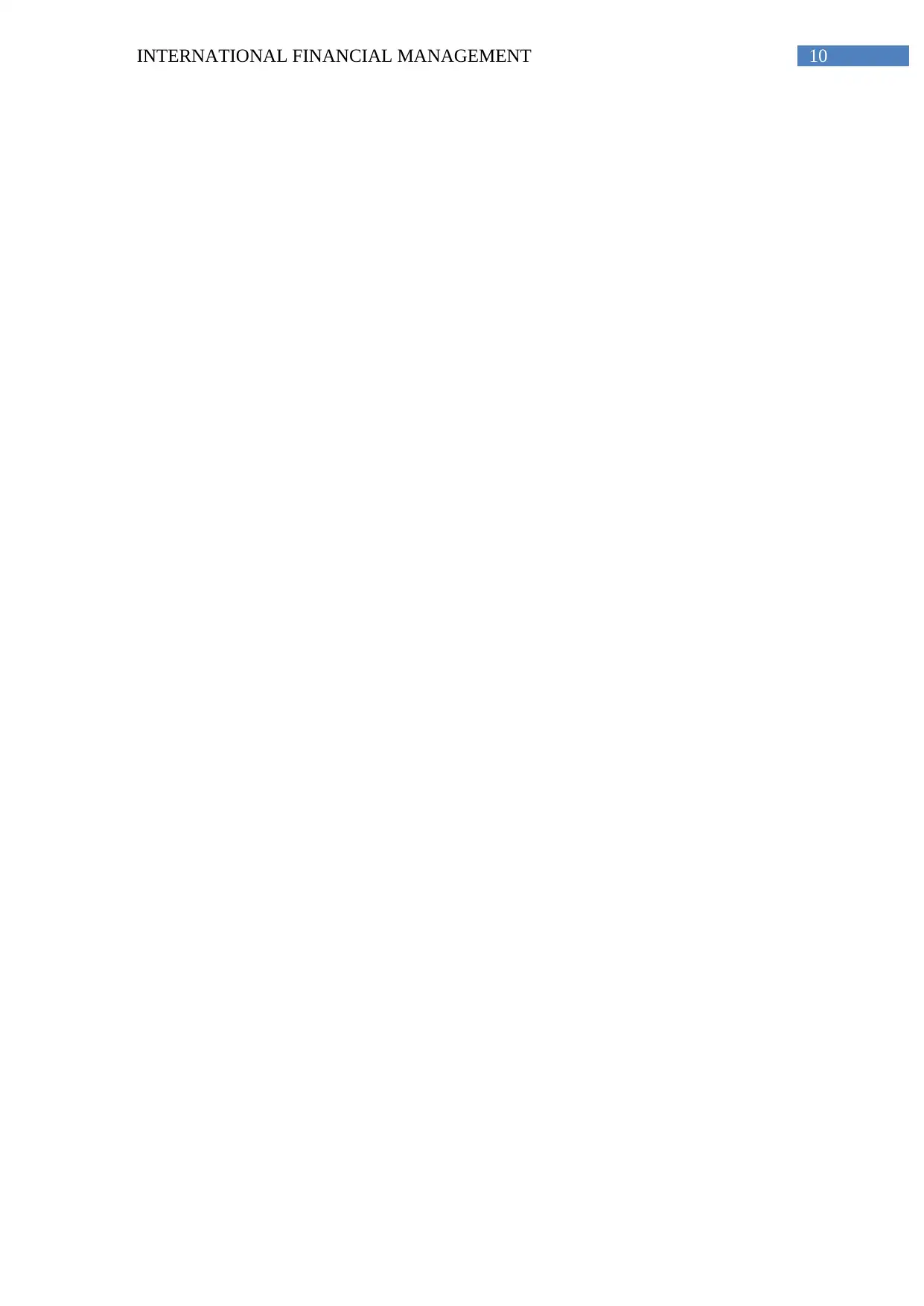
10INTERNATIONAL FINANCIAL MANAGEMENT
1 out of 11
Related Documents
Your All-in-One AI-Powered Toolkit for Academic Success.
+13062052269
info@desklib.com
Available 24*7 on WhatsApp / Email
![[object Object]](/_next/static/media/star-bottom.7253800d.svg)
Unlock your academic potential
© 2024 | Zucol Services PVT LTD | All rights reserved.




